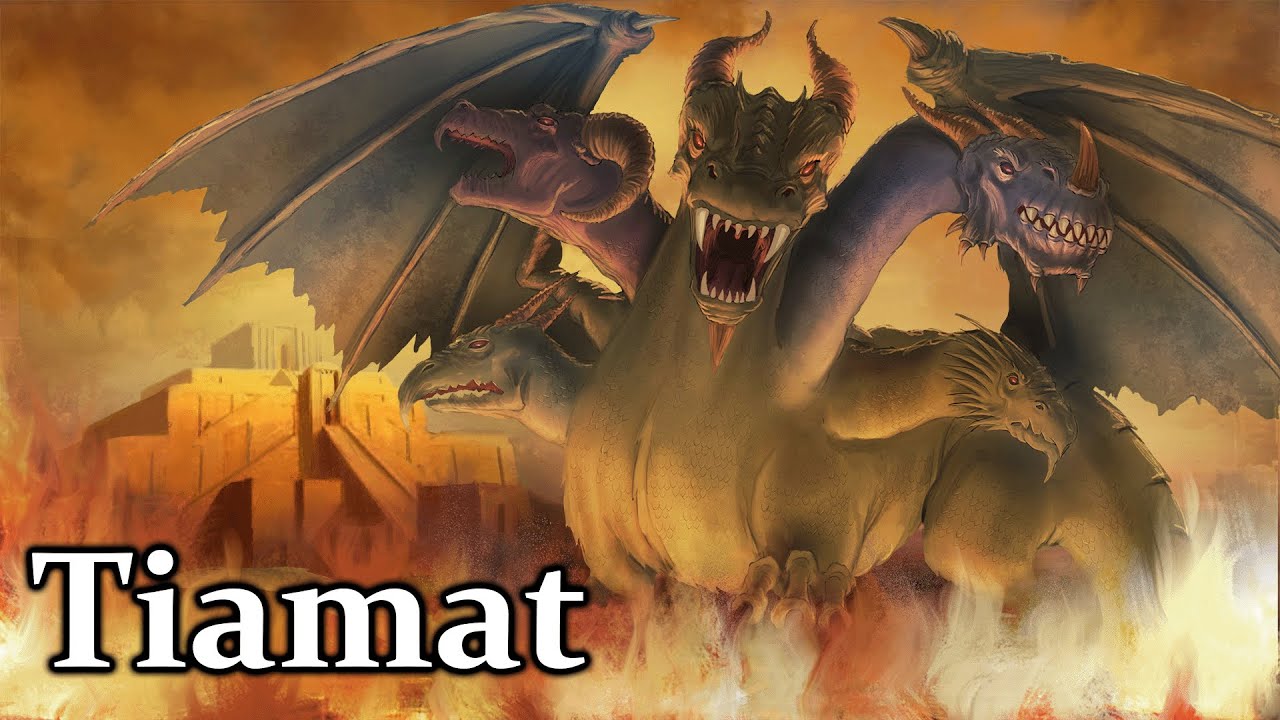In the video “The Creation Story of the Mesopotamian Goddess Tiamat,” Mythology & Fiction Explained delves into the fascinating mythology of Tiamat and the Enuma Elis creation story. Tiamat holds the title of the mother of monsters and is considered the creator of life in Mesopotamian mythology. However, there are rivalries and discrepancies in the various stories of creation. The Enuma Elis, the Babylonian Creation myth, is a more developed and detailed account that tells of Tiamat’s disapproval and growing contempt for her children, leading to chaos. Enki, along with other gods, ultimately kills Abzu and locks Tiamat away, while Tiamat creates an army of 11 hybrid creatures to challenge her children. Marduk, Enki’s son, emerges as the champion who defeats Tiamat and becomes the supreme god. Tiamat’s body is used to create the heavens and the earth, symbolizing the triumph of good over evil. The portrayal of Tiamat varies, sometimes as a beautiful creator goddess and other times as an evil monstrous dragon. The Enuma Elis provides a captivating and complex creation story compared to alternative versions, sparking further exploration into Mesopotamian mythology and its myths surrounding Tiamat.

The Creation Story of the Mesopotamian Goddess Tiamat
Introduction to Mesopotamian Mythology
Mesopotamian mythology is an ancient belief system that was practiced in the region known as Mesopotamia, which is present-day Iraq. This mythology is rich and diverse, providing fascinating stories and insights into the ancient Mesopotamian worldview. One of the prominent figures in Mesopotamian mythology is the goddess Tiamat, who plays a pivotal role in the creation story of the world.
Key Concepts and Characters
Tiamat – The Mother of Monsters and Creator of Life
Tiamat is a central figure in Mesopotamian mythology as she represents the primeval sea and the chaos that existed before the creation of the universe. According to the myth, she is depicted as a dragon-like creature, embodying both the power of creation and destruction. Tiamat is often regarded as the mother of all monsters and the creator of life, playing a significant role in shaping the cosmos.
Abzu – The Primordial Being
Abzu, often referred to as Apsu, is another important character in the Mesopotamian creation myth. He is the embodiment of fresh water and represents the sweet waters from underground aquifers that nourish the earth. Abzu is initially seen as a benevolent god, but his actions later provoke Tiamat and lead to chaos.
Enki – The God of Wisdom
Enki, also known as Ea, is one of the prominent gods in Mesopotamian mythology and plays a crucial role in the creation story of Tiamat. He is the god of wisdom, magic, and freshwater, often portrayed as a wise and knowledgeable deity. Enki possesses the ability to manipulate the universe and helps shape the destiny of the gods and monsters.
Marduk – The Champion and Supreme God
Marduk, the champion and supreme god in Mesopotamian mythology, becomes a significant player in the story of Tiamat. He embodies the power and strength needed to defeat Tiamat and restore order in the cosmos. Marduk’s rise to power symbolizes the ascendancy of Babylon and the city’s growing influence in Mesopotamian culture.
The Enuma Elis: A Babylonian Creation Myth
The Enuma Elis, also known as the “Epic of Creation,” is a Babylonian creation myth that provides a detailed account of the origin of the universe and the role of Tiamat. This myth holds immense importance in understanding the Mesopotamian worldview and their beliefs about the creation of the world.
Tiamat and Abzu: The Primordial Beings
According to the Enuma Elis, Tiamat and Abzu existed before all creation as primordial beings. They symbolized the chaotic and untamed forces that roamed the universe. Tiamat represented the saltwater sea, while Abzu symbolized the freshwater underground. Initially, these two entities coexisted peacefully until Abzu’s actions incited Tiamat’s fury.
Tiamat’s Disapproval and Chaos
Tiamat became increasingly upset with the actions of Abzu, who planned to destroy the younger gods for making noise and disturbing his peaceful domain. Tiamat, in her rage, decided to generate a host of monsters and enlisted Kingu, a god, as her right-hand man. This act of creation by Tiamat aimed to challenge the divine order and restore chaos.
Enki and the Gods
The gods were alarmed by Tiamat’s growing army of monsters and feared the destruction that loomed over them. In their desperate attempt to restore order, the gods turned to Enki for his wisdom and assistance. Enki devised a plan to save the divine order and took swift action to ensure the gods’ survival.
Killing Abzu and Locking Tiamat Away
Enki confronted Abzu and, recognizing the impending danger he posed, managed to subdue and kill him. By doing so, Enki freed the gods from Abzu’s tyranny, but Tiamat still posed a great threat. Determined to protect the gods, Enki locked Tiamat away, limiting her destructive power and separating her from the realm of the gods.
Tiamat’s Army of Hybrid Creatures
Although imprisoned, Tiamat was not defeated. Fueled by her anger and desire for revenge, she continued to conceive monstrous beings to challenge the gods and regain her freedom. These creatures were a combination of various species, blending the features of both animals and gods. The existence of Tiamat’s army intensified the conflict between chaos and order.
Marduk: The Champion and Supreme God
Recognizing the urgency to defeat Tiamat and her creations, the gods requested Marduk, the son of Ea, to take on the role of a champion. Marduk agreed and set forth to confront Tiamat, equipped with divine weapons and powers bestowed upon him by the gods.
Defeating Tiamat and Capturing the Gods and Monsters
In an epic battle, Marduk faced Tiamat and prevailed. He managed to pierce her heart, thus ending her reign of chaos and destruction. As a demonstration of his supreme power, he bound the captured gods and monsters and established his rule as the supreme deity. Marduk’s victory marked the triumph of order over chaos and the establishment of a new cosmic order.
Conclusion
The creation story of the Mesopotamian goddess Tiamat offers a captivating glimpse into the ancient Mesopotamian worldview. It portrays the eternal struggle between chaos and order, with Tiamat embodying the chaotic forces that threatened the divine order. Through the intervention of Enki and the rise of Marduk, order is restored, and a new cosmic order is established, solidifying Marduk’s position as the supreme god. The story of Tiamat remains a testament to the human desire to understand and find meaning in the mysteries of creation.
